Dreams come in all different sizes, shapes,
and packages. I had a dream of sailing around the world on a
multihull, and I chose a Privilege 39 Catamaran, an offshore Dream
Machine that can take you anywhere you have the courage to point the
bows.
Dreams machines must be honest. They must deliver the goods when you
are sailing on the high seas. Too many boats look great while they sit
at the dock, but when you take them offshore, a demolition derby begins.
Our
Dream Machine is a Privilege 39 catamaran. It's thirty-nine feet
five inches long and twenty one feet wide. It has a draft of about
four feet fully loaded with cruising gear. It's built for offshore
sailing, and will take you anywhere you want to go in the world.
That
being said, a catamaran this size is better suited for sailing downwind
in the trade winds rather than sailing in the high latitudes found in
arctic regions. It can sail in the high latitudes, and Exit Only would
survive sailing in those regions, but the boat wasn't designed for high
latitude cold weather sailing. In those regions, catamarans over sixty
feet in length with a high bridge deck clearance are better suited to
the task. Nevertheless, a catamaran my size can be sailed to any
destination if it is done in a conservative manner. But there's no
doubt about it, at high latitudes, bigger is better when you are in a
catamaran.
What
are the specific features on Exit Only that make it a good Dream
Machine?
1.
It's built tough to Bureau Veritas Standards. Bureau Veritas certifies
that a yacht meets the standards set up by the French government for
offshore sailing yachts. Exit Only is a heavy yacht. Its construction
is substantially heavier than most catamarans its size. That means it's
not a greyhound racing from point to point. It's more like a tank that
can take a licking and keep on ticking. It won't set any speed
records, but if conditions get nasty, it will survive. Whenever I am in
a gale or storm, I am glad that I am securely hunkered down in Exit Only
because I know this catamaran is up to the task.
Follow Offshore Catamaran on Facebook.

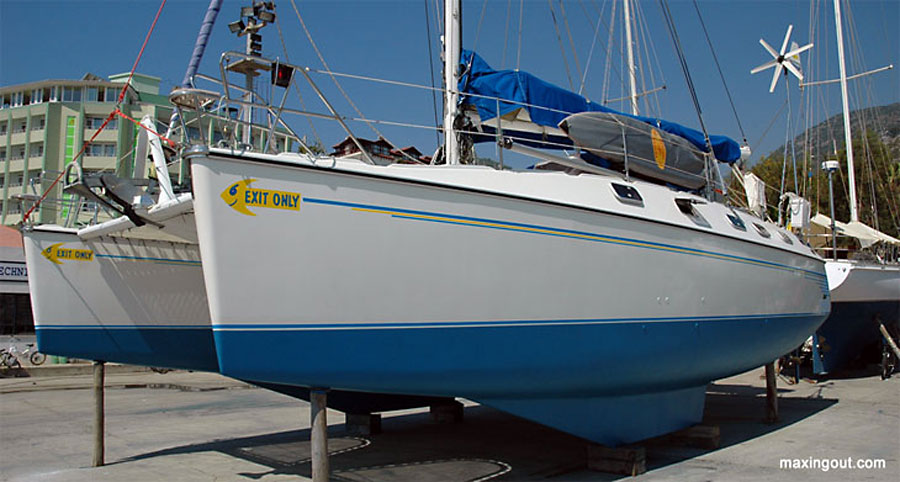
2.
Exit Only is essentially unsinkable unless you break it into small
pieces by getting run down by a ship. It has four water tight
compartments in each hull, and if you knock a hole in one of the
compartments, the boat will not sink. This feature is extremely
important. When my yacht was sailed from France to England by a
delivery skipper, the boat struck something that knocked an eight inch
hole in the starboard bow. There is a collision bulkhead about one foot
back from the leading edge of the bow, and that bulkhead stopped water
from entering the next watertight compartment. Only a liter of water
entered the first water tight compartment, and the yacht was never at
risk of sinking. The same size hole in a monohull yacht would cause it
to sink in less than ten minutes. Those watertight compartments were a
great comfort when I sailed through the tsunami debris field south of
Sri Lanka after the catastrophic Asian tsunami of 2004. There were
giant partially submerged trees floating in the waters south of Galle,
Sri Lanka, and any one of them could have put a gaping hole in my bow.
Having collision bulkheads and watertight compartments is good, and
every catamaran should have them.
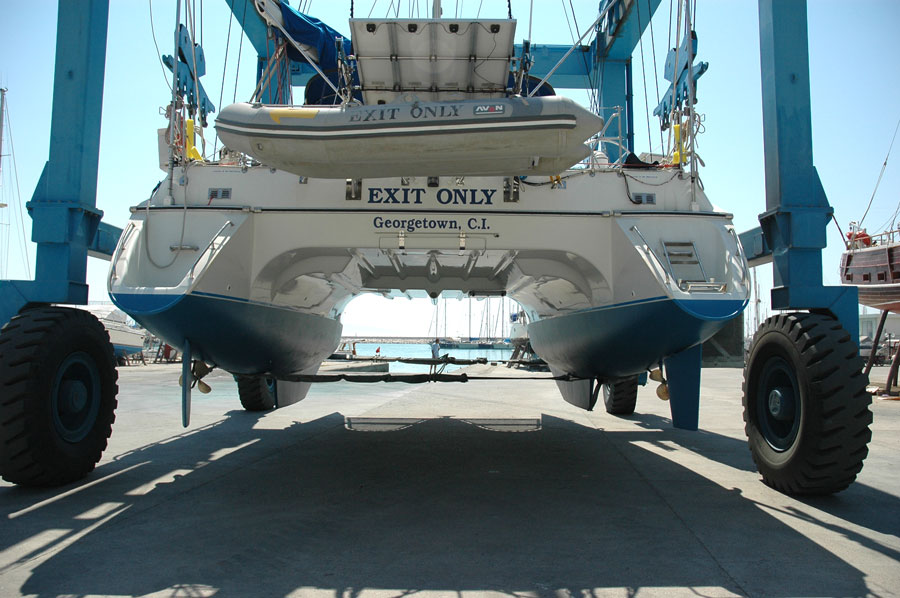
3.
Exit Only has two steering wheels. Two wheels are an excellent idea.
Did you ever see a jet airplane with only one steering wheel? If one
wheel breaks, the second one is ready to go. Not a big deal you might
say, but talk to sailors who have broken the steering cable that goes
from their one and only steering wheel to the steering quadrant. Their
trip rapidly becomes a hellish experience if they can't repair the
steering. They have to steer their yacht with a jury rigged emergency
tiller. On Exit Only, we have four ways to steer the yacht. There is
steering wheel one, steering wheel two, emergency tiller, and finally,
the push buttons on the autopilot. That type of redundancy means we
will probably never experience a steering emergency.
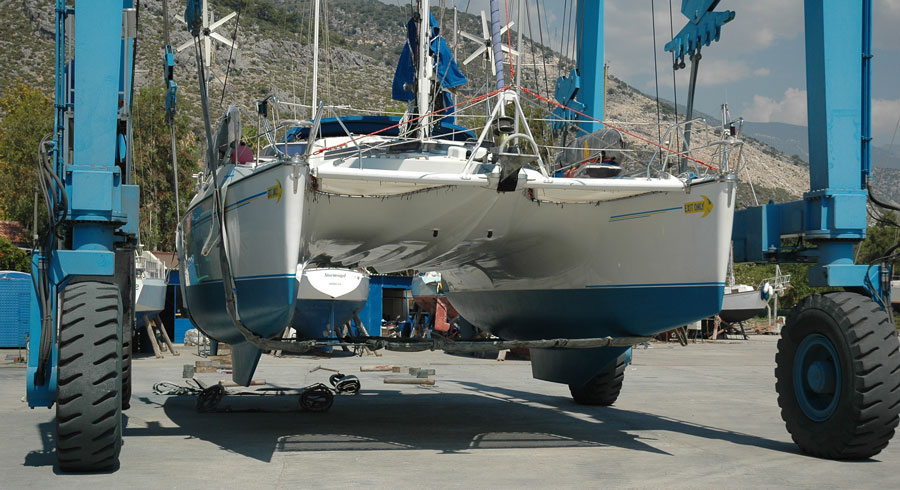
4.
Exit Only has two rudders. Two rudders are not optional in a
catamaran. You have two hulls and you need two rudders to optimally
control your yacht. I have seen yachts that lost their rudder or the
rudder disintegrated because of poor construction or damage from
striking submerged objects. Having a second rudder means you still have
at least modest control of the yacht if one rudder becomes inoperable or
disappears in the depths of the sea.
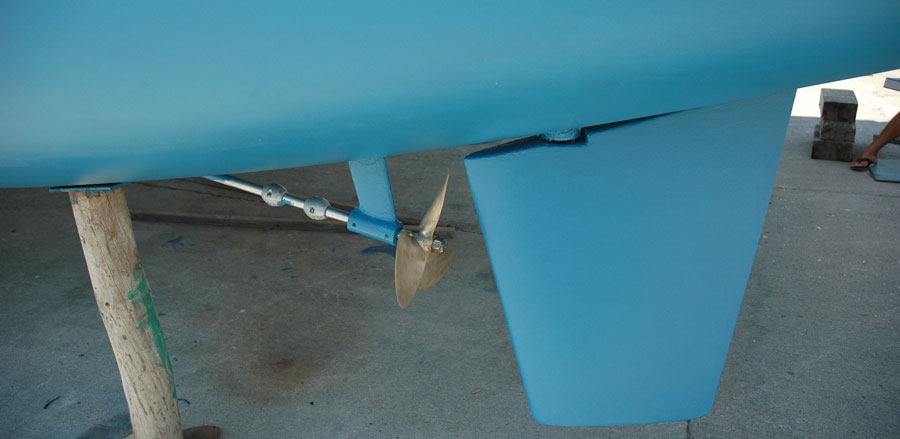
5.
Exit Only has two engines. Not all catamarans have two engines - some
have a center nacelle in which they place a single engine that provides
all the power for moving the yacht when there is no wind. Exit Only has
one engine in each hull which gives redundancy should one engine fail,
and it makes the yacht extremely maneuverable in tight quarters under
power. Two engines double the horsepower available when you need to
push into strong headwinds and contrary seas. Normally we use only one
engine at a time, moving at five knots under power. But when we need
to, we can turn on the second engine and get the speed up to seven and
a half knots. Two engines give us the power to motor to windward in
winds up to thirty-five to forty knots. When we navigate through tricky
passes in atolls, we always run two engines just in case one engine
fails at a critical moment. You have great peace of mind knowing that
in an emergency there is a spare engine to get you through. Each of our
engines has its own separate fuel system so if contaminated fuel shuts
down one engine, the second will be able to continue running without
interruption.
6.
Exit Only has four solar panels that realistically put fifty amp hours
of power into the deep cycle batteries each day.
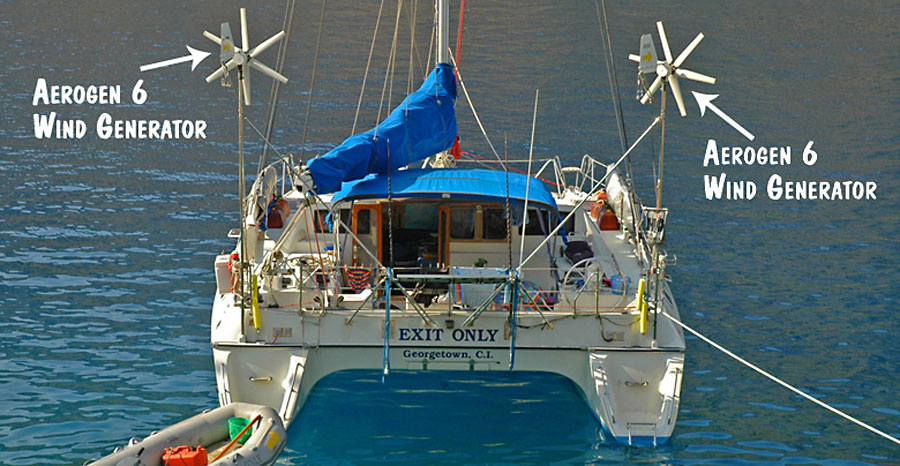
7.
Exit only has two Aerogen wind generators. The two generators pump a
combined two hundred amp hours into the battery banks each day while we
are at anchor or sailing in the trade winds. When the winds are
blowing, we can sit for weeks at a time without having to turn on the
engines to generate electricity.
8.
Exit Only uses a double headsail downwind sailing rig assisted by two
eighteen foot spinnaker poles putting 1000 square feet of sail out in
front of the yacht. We cruise effortlessly downwind in the trade winds
day after day. This rig has carried us 20,000 miles downwind as we
sailed around the world. Sometimes we keep this rig up for weeks at a
time. The double headsails can be reefed, and it puts the center of
effort of the sails at the bow pulling us downwind with a balanced
helm. The helm is so well balanced that the autopilot can almost go on
vacation - it has so little work to do as it keeps the boat tracking
downwind.
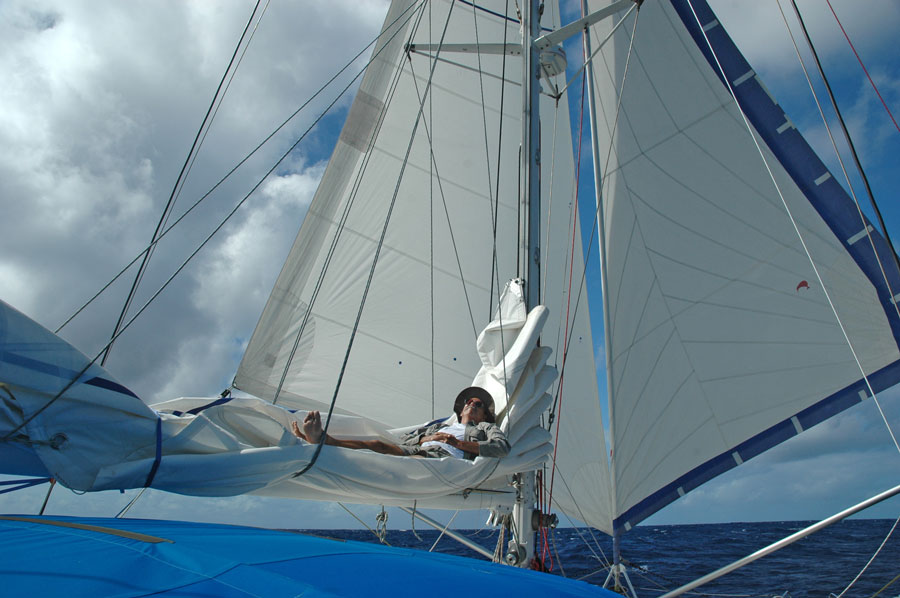
9.
Exit Only has an Autohelm 7000 autopilot that puts out 1200 pounds of
linear force directly into the steering quadrant. Our autopilot has
steered Exit Only 33,000 miles around the world. We keep a complete
spare autopilot on board, and have had to use the spare only twice. In
French Polynesia, a failed bearing stopped the autopilot until the
bearing was replaced, and while sailing up the Great Barrier Reef, we
stripped the epicyclic gears in the autopilot, and I had to replace
them. Not bad for 33,000 miles of service offshore. In the entire trip
around the world, I have hand-steered the yacht for less than
twenty-four hours total.
10.
Exit Only has a seventy pound Beugel anchor. Exit Only has dragged CQR
anchors all across the Pacific Ocean. It didn't matter whether we used
our forty-five pound CQR or our sixty pound CQR, we
dragged them causing quite a few sleepless nights. The problem with the
CQR design was that it was difficult to set in marginal bottoms, and it
couldn't be trusted to reliably reset when wind and current changed the
pull on the anchor. Once we got our Beugel, our anchor dragging woes
were over. The Beugel sets quickly and resets well when there is a
change in wind or tide. It also works well in tight anchorages. In
fifteen thousand miles of sailing from Australia to the Caribbean, I had
the anchor drag once in the Red Sea in fifty feet of water where the
bottom was sloping rapidly away from land. I also dragged anchor one
time in the Canary Islands in forty feet of water in an area known to
have poor holding. When I put the anchor down, I back down on it with
both engines in full reverse, and when the anchor is firmly set, I put
my head on my pillow and sleep soundly through the night. No anchor
watch for me because I know my anchor will hold.
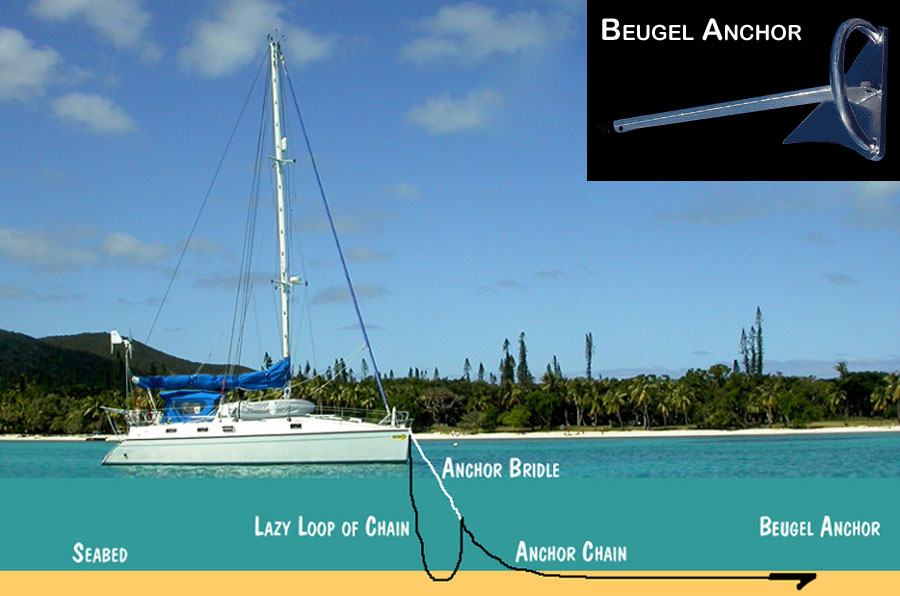
11.
Exit Only has two stainless steel chainplates bolted through the decks
at the bows. There are large diameter stainless steel bails welded to
the chainplates, and the bails are a chafe free attachment point where I
can shackle my parachute storm anchor if we ever get in a mega storm.
The chainplates are twenty-five inches long, and they will never pull
out of the deck even in extreme conditions. When I was 300 miles north
of New Zealand hunkered down in a fifty knot gale, the parachute sea
anchor give us a secure refuge in our turbulent water world.

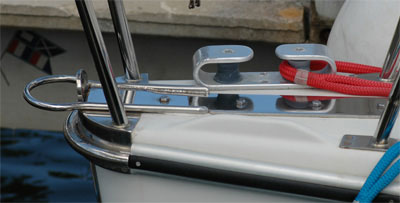
12.
Exit Only sails level and doesn't roll when going downwind in the
trades. Monohulls roll relentlessly to port and starboard when sailing
downwind. Imagine what your life would be like to sail across the
Atlantic for two weeks if you rolled from side to side half a million
times during the trip. That never happens in a catamaran, and is one of
the reasons trade wind sailing is so great in a catamaran. It's truly
no bruising cruising.
13.
The remainder of the features on Exit Only are fairly standard for a
cruising yacht, whether it's a monohull or a multihull. Those features
include: radar, high frequency radio for ship to ship communication and
email, VHF radio, EPIRB - emergency position indicating radio beacon,
Iridium satellite phone, GPS, C-map computerized charts, complete
survival gear and emergency gear, Givens six man life raft, and a
reverse osmosis watermaker.
This
list could go on for more than a dozen pages. Our inventory of spare
parts and sailing gear is too long to enumerate.
Exit Only has been our home on the high seas
for more than eleven years. It's an honest Dream Machine that has lived
up to our expectations and taken us safely around the world. You can't
ask much more than that from any yacht.
THE FACTS OF LIFE RAFTS
Imagine that you were flying in an airplane and the stewardess came to
you, put a parachute on your back and pushed you out the door without
telling you how to open the chute. Sounds absurd, insane and
impossible?
That is exactly what happens to most yachties when they pull the rip
chord on their life raft. They donít have a clue about how to properly
deploy and use it. They see their life raft inflated for the first time
when they abandon ship.
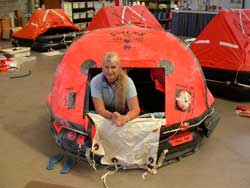 Ignorance
about life rafts is epidemic. Every couple of years, yachties take
their raft to an inspection station and a week later, pick it up. They
feel that the money paid to the inspector is an insurance policy against
disaster. This approach guarantees they will remain ignorant about how
to properly deploy and use this important piece of survival gear.
Ignorance
about life rafts is epidemic. Every couple of years, yachties take
their raft to an inspection station and a week later, pick it up. They
feel that the money paid to the inspector is an insurance policy against
disaster. This approach guarantees they will remain ignorant about how
to properly deploy and use this important piece of survival gear.
Each time you have your raft inspected, you have a golden opportunity to
see it fully inflated and familiarize yourself with its contents and
proper use. We took our life raft to Marine Safe in Slaackís Creek
south of Brisbane. The hour that we spent watching our raft being
inflated and inspected could save our lives. Here are some of the facts
of Life Raft Life.
1. Before you launch a life raft, tie the rip chord to the yacht
so the raft doesnít blow away and disappear in the darkness. The rip
chord on our life raft is sixty feet long. So we donít expect our raft
to inflate immediately after we pull out a few feet of rip chord. The
extra chord is really not extra. Itís there to allow the raft to sit a
safe distance away from the yacht.
2. When you launch your raft, throw it in the water downwind so that
it wonít be damaged by blowing up against the yacht.
3. Donít deploy the raft sea anchor until you are well away from
yacht. You donít want the sea anchor or raft to become entangled in the
yacht.
4. Tie your Go Bags containing survival supplies to the rip chord so
that they wonít be lost if they get washed overboard. You can use the
rip chord to recover a Go Bag and bring it into the raft.
5. There is a knife in a pocket on the canopy where you climb on
board the raft. Use this knife in an emergency to cut the tether that
joins the raft to the boat if the boat actually sinks.
6. There are water activated batteries that automatically turn on a
flashing light on the canopy of the raft so that you can see where the
raft is located if you must abandon ship in the dark.
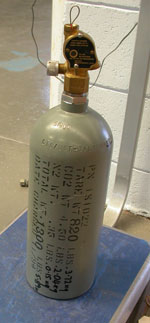 7.
The carbon dioxide bottle contains thirty percent extra carbon dioxide
to be sure there is enough gas to fully inflate the raft. This extra
carbon dioxide escapes through over pressure valves in the tubes of the
raft. These valves are tested during inspection to make sure that they
open and close properly during inflation. If the valves should leak,
the raft contains screw-in plugs to stop the gas leak.
7.
The carbon dioxide bottle contains thirty percent extra carbon dioxide
to be sure there is enough gas to fully inflate the raft. This extra
carbon dioxide escapes through over pressure valves in the tubes of the
raft. These valves are tested during inspection to make sure that they
open and close properly during inflation. If the valves should leak,
the raft contains screw-in plugs to stop the gas leak.
8. Life rafts must be inflated and tested for many hours to make
sure that there are no slow leaks in the material or seams. If they
donít maintain their pressure, there is a leak that must be found and
fixed.
9. Inspectors tell if the carbon dioxide inflation cylinder is full
and ready for action by weighing the cylinder. The weight of the
compressed carbon dioxide is printed on the side of the cylinder (2.04
kilograms). If the cylinder weight is correct, then carbon dioxide has
not leaked from the cylinder and itís ready to go. Total cylinder
weight on our last life raft exam in New Zealand was 5.89 kilograms.
10. The inspector tested the emergency hand inflation pump and
showed us how to attach it to the inflation tubes and floor.
11. The life raft canopy has a device for catching rain water that
drains into a tube attached to a plastic bladder in which to store fresh
water.
12. The inspector showed us the contents of the survival pack
tethered to the floor of the raft. Included are food rations, pouches
of water, medical kit, seasickness medicine, signal mirror, signaling
flares, fishing kit, repair/patching kit, flashlight with spare
batteries and bulb. All expired items must be replaced.
13. Our Go Bags need to have lines attached to them so that they can
be tethered inside the raft. This keeps survival supplies from being
washed out of the raft in extreme conditions.
14. There are two inflation tubes on the Givens raft. The gas
supply to each tube is separate and either tube by itself can support
the raft and its occupants.
15. If you store your life raft where it can get wet, moisture will
destroy it. Most life rafts are vacuum bagged so that there is no
chance for ingress of water while the raft sits in its canister on deck
ready for an emergency.
-- Conclusion: The next time you get your life raft inspected,
watch the inspectors inflate the raft and become familiar with the
features unique to that raft. There is no room for cutting corners in
the life raft department. You must know how to deploy and use it. You
must have complete confidence in the people who have inspected and
repacked it.
Inspecting life rafts should be done by professionals who have the tools
to do the job properly and the skills to repack it so that water will
never get inside. Honest and competent inspectors can save your life.
Dishonest and shoddy inspectors could cost you your life.
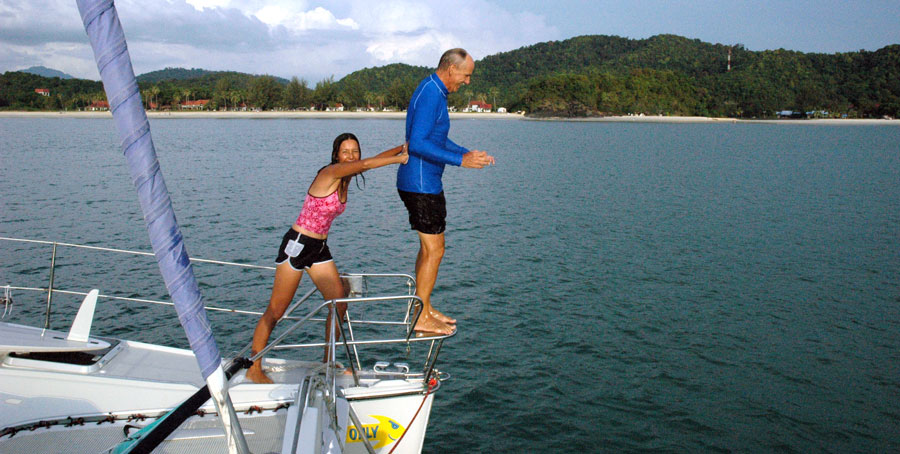
DON'T HESITATE!
TAKE THE PLUNGE NOW AND
ORDER
THE RED SEA
CHRONICLES. JUMP INTO A
GREAT CRUISING CATAMARAN DVD. YOU WILL BE GLAD THAT YOU DID!